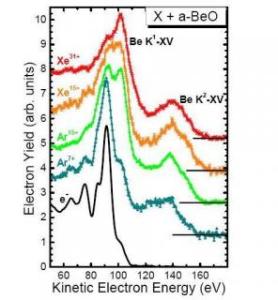Nov 4 2010
Scientists from Helmholtz-Zentrum Berlin (HZB) observed exotic behaviour from beryllium oxide (BeO) when they bombarded it with high-speed heavy ions: After being shot in this way, the electrons in the BeO appeared "confused", and seemed to completely forget the material properties of their environment.
The researchers' measurements show changes in the electronic structure that can be explained by extremely rapid melting around the firing line of the heavy ions. If this interpretation is correct, then this would have to be the fastest melting ever observed. The researchers are publishing their results in Physical Review Letters.
 This is the K1-XV-line-spectrum of beryllium-oxide
This is the K1-XV-line-spectrum of beryllium-oxide
In his experiments, Prof. Dr. Gregor Schiwietz and his team irradiated a beryllium oxide film with high-speed heavy ions of such strong charge that they possessed maximum smashing power. Unlike most other methods, the energy of the heavy ions was chosen so that they would interact chiefly with their outer valence electrons. As heavy ions penetrate into a material, there are typically two effects that occur immediately around the fired ions: the electrons in the immediate surroundings heat up and the atoms become strongly charged. At this point, Auger electrons are emitted, whose energy levels are measurable and show up in a so-called line spectrum. The line spectrum is characteristic for each different material, and normally changes only slightly upon bombardment with heavy ions.
As a world's first, the HZB researchers have now bombarded an ion crystal (BeO), which has insulator properties, with very high-speed heavy ions (xenon ions), upon which they demonstrated a hitherto unknown effect: The line spectrum of the Auger electrons changed drastically – it became "washed out", stretching into higher energies. Together with a team of physicists from Poland, Serbia and Brazil, the researchers observed distinctly metallic signatures from the Auger electrons emitted by the heated BeO material. The Auger electrons appeared to have completely "forgotten" their insulator properties. The researchers see this as clear evidence that the band structure breaks down extremely rapidly when the BeO is bombarded with heavy ions – in less than about 100 femtoseconds (one femtosecond is a millionth of a millionth of a millisecond). This breakdown is triggered by the high electron temperatures of up to 100000 Kelvin. In the long term, however, the material of the otherwise cold solid remains overall intact.
The HZB researchers' results deliver strong evidence of ultra-fast melting processes around the firing line of the heavy ions. This melting is followed by annealing that deletes all permanent signs of the melting process. Prof. Schiwietz hopes to find other ionic crystals that exhibit the same rapid melting process, but in which the annealing process is suppressed. If any are found, then a conceivable application would be programming at femtosecond speeds.
Source: http://www.helmholtz.de/